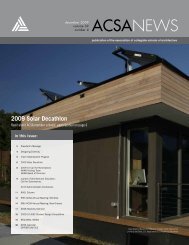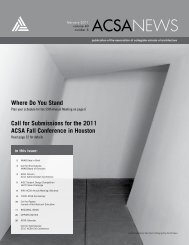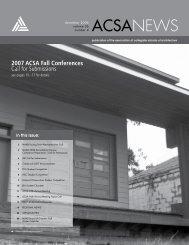digital aptitudes - Association of Collegiate Schools of Architecture
digital aptitudes - Association of Collegiate Schools of Architecture
digital aptitudes - Association of Collegiate Schools of Architecture
Create successful ePaper yourself
Turn your PDF publications into a flip-book with our unique Google optimized e-Paper software.
THURSDAY, MARCH 1, 2012 - 2:00PM - 3:30PM<br />
Registration and Projection: The Mediations <strong>of</strong> Urban<br />
Imaging Technologies<br />
McLain Clutter, University <strong>of</strong> Michigan<br />
Aerial Vision-Based Model <strong>of</strong> Urbanism<br />
El Hadi Jazairy, University <strong>of</strong> Michigan<br />
Google Earth and airplanes give access to map-scale top-down<br />
views <strong>of</strong> cities. As a result, observers have a perspective allowing<br />
them to view cities as a whole in a towering position as if they controlled<br />
it from outside. This position empowers policy-makers and<br />
city users giving them a sense <strong>of</strong> control over the visualized object<br />
thereby making it submissive to their desires. This paper is an attempt<br />
to relate the meaning and agency <strong>of</strong> aerial vision with the<br />
emergence <strong>of</strong> a ‘new geography from above’ in the Gulf.<br />
Modeling Spatial Activity Distributions in Complex<br />
Urban Conditions: The Markov Chain Model for<br />
Weighting Spaces with Attractors<br />
Ipek Rohl<strong>of</strong>f, Mount Holyoke College<br />
Kurt Rohl<strong>of</strong>f, Raytheon/BBN Technologies<br />
This paper presents first insights from an ongoing investigation into<br />
how to predict movement distributions influenced by factors other<br />
than street networks. In current spatial analysis models, the ability<br />
to predict the effect <strong>of</strong> attractors other than street network properties<br />
on movement distributions has been limited. This paper introduces<br />
an analysis approach that incorporates normalized weightings<br />
on spaces with attractors along with network properties in order to<br />
provide finer grain analysis explaining movement distributions within<br />
urban complexity beyond the street network. This analysis approach<br />
is based on Markov chain models which have been widely used in<br />
other domains to model complex systems. We use the Markov chain<br />
modeling approach to represent network properties and attractor effects<br />
with normalized weightings to estimate probabilistic movement<br />
distributions in a computationally tractable manner. We argue that urban<br />
environments with business districts in segregated locations and<br />
green open spaces integrated with the urban fabric are cases <strong>of</strong> urban<br />
complexity where movement distribution cannot be explained merely<br />
by street networks but with attractors incorporating programmatic<br />
and environmental content. Our conclusion is that a comprehensive<br />
model utilizing Markov chains can be useful to detect the effects <strong>of</strong><br />
building density and environmental content on movement, yet further<br />
research is required to establish weighting criteria.<br />
Representing Information: Envisioning the City<br />
through Data<br />
Karen Lewis, Ohio State University<br />
The constructed world is replete with information that governs and<br />
controls its organization. From railroads to highways, building codes<br />
to zoning regulations, the design and development <strong>of</strong> the contemporary<br />
environment is managed by strategies <strong>of</strong> physical and visual<br />
organization. Architects’ interest in this globally networked environment<br />
is reflective <strong>of</strong> an increasing awareness and attention to the<br />
multi-variant world, one invested in infrastructural systems that support<br />
productivity in lieu <strong>of</strong> pictures and is reflective <strong>of</strong> a new global<br />
and electronic economy based on intangibles – ideas, information and<br />
relationships. The effects <strong>of</strong> these systems, once only theorized and<br />
simulated through abstract models, is given attention via the measurement,<br />
collection and processing <strong>of</strong> their effects.<br />
As emerging technologies have enabled new ways <strong>of</strong> measuring fluvial<br />
global, urban and regional networks, new representation techniques<br />
have enabled design practice to occupy and design with<br />
information, rather than merely represent its influence. Through<br />
techniques <strong>of</strong> clarification, simulation, augmentation and revelation,<br />
architecture mobilizes data visualization into architecture praxis.<br />
Spectacle <strong>of</strong> the Hyper-Real: Environmental<br />
Simulation, Cybernetic Subjects, and Urban Design<br />
Anthony Raynsford, San Jose State University<br />
Like Renaissance perspective before it, contemporary environmental<br />
simulation in urban design is an exceedingly codified and artificial<br />
visual construction whose success, likewise, lies in its reassurance<br />
<strong>of</strong> a certain scientific precision and point-by-point correspondence.<br />
Using a few key examples, I would like to suggest that current, hyper-realistic<br />
simulations, such as the Glasgow Urban Model, have a<br />
three-part history, dating back to the 1950s when experiments at<br />
MIT first connected cybernetic models <strong>of</strong> experience to the formal<br />
aesthetics <strong>of</strong> film. At this stage, simulations remained highly diagrammatic,<br />
translating dynamic urban sequences into an array <strong>of</strong> visual<br />
media, each <strong>of</strong> which was meant to capture some aspect <strong>of</strong> the<br />
totality <strong>of</strong> the visual experience <strong>of</strong> the city. This phase was followed<br />
by an intermediate stage in the 1970s, in which computer technology<br />
became embedded within specific techniques <strong>of</strong> Hollywood<br />
special effects in order to simulate a more-or-less total environmental<br />
experience, with extraordinary levels <strong>of</strong> detail and precision. This<br />
embedding <strong>of</strong> special effects technology coincided with a populist<br />
suspicion <strong>of</strong> urban design expertise that had begun in the late 1960s<br />
and that demanded ever-wider accessibility and transparency <strong>of</strong><br />
urbanistic representations. Realism now entailed both close, optical<br />
replications <strong>of</strong> urban experience and a type <strong>of</strong> cinematic immediacy<br />
that would be familiar to, and hence legible for a broad audience <strong>of</strong><br />
perceivers. The final stage emerged with the adoption <strong>of</strong> CAD modeling<br />
and animation systems that gradually became spliced into and<br />
ultimately supplanted traditional film, without, however, displacing<br />
the filmic visual codes and their subjective viewpoints. Where Renaissance<br />
perspective projected a static, <strong>of</strong>ten universalized viewer,<br />
centered within an abstract spatial grid, contemporary <strong>digital</strong> simulations<br />
tended later to project a variable and mobile ‘consumer’ <strong>of</strong><br />
urban space, a cybernetic subject <strong>of</strong> endless feedback rather than a<br />
Platonic knower <strong>of</strong> ideals. The demand for realism, also, became an<br />
appetite for the spectacular results <strong>of</strong> simulation per se. Simulated<br />
cities became sites for a new kind <strong>of</strong> hyper-reality, both in the sense<br />
<strong>of</strong> their intensely detailed duplication <strong>of</strong> the physical and in terms <strong>of</strong><br />
their acting as increasingly autonomous substitutes for the real. The<br />
replacement <strong>of</strong> physical models and film by <strong>digital</strong>ly scanned environments<br />
and <strong>digital</strong> renderings have further widened the scope for<br />
hyper-realistic spectacle, whether in the form <strong>of</strong> animated films that<br />
are choreographed in order to produce particular effects <strong>of</strong> motion,<br />
or interactive spaces controlled, in the manner <strong>of</strong> games, through a<br />
set <strong>of</strong> rules by which users move through the space. Although potentially<br />
neutral banks <strong>of</strong> visual and spatial information, the models,<br />
in practice, need to be organized in particular ways in order to simulate<br />
the effects <strong>of</strong> the real and reach a general audience, where they<br />
can be consumed as <strong>digital</strong>, cinematic media.<br />
Digital Apptitutes + Other Openings - Boston, MA - 9








